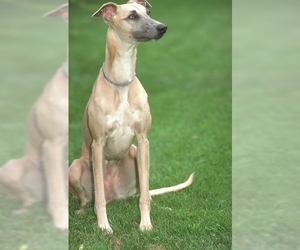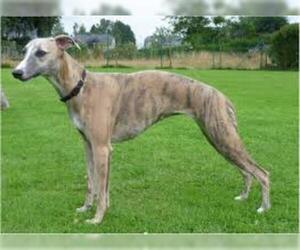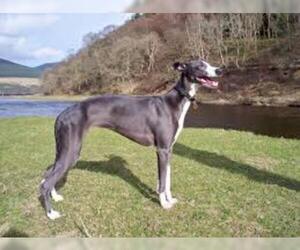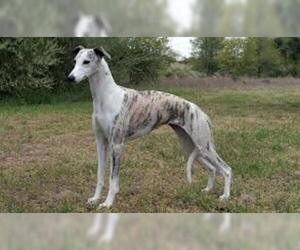
All about Whippet dog breed
A.K.A. :Snap Dog, Poor Man's Racehorse, Lightning Fast, Pocket Greyhound
Size
Grooming requirements
Exercise requirements
Good with other dogs
Watchdog ability
Energetic
Training requirements
Playful
Affectionate
Good with other pets
Good with children
Good with strangers
Winter
Summer
Healthiness
Protective
Life Span
| Pure Breeds | Member |
| Breeds A - Z | W |
| Breeds by Group | Hound Sighthound & Pariah |
| Breeds by Trait | Fast Dog Breeds Low Shedding |
| Overview: | The Whippet, often affectionately called the "poor man's racehorse," is a graceful and athletic sighthound originating from England, bred for coursing small game and competitive racing. Possessing a sleek, aerodynamic build, they feature a deep chest, slender waist, and long, elegant legs, perfectly adapted for their characteristic burst of speed. Despite their athletic prowess, Whippets are renowned for their gentle, docile temperament, making them exceptional companions. They are generally quiet and calm indoors, earning them the nickname "the couch potato of the dog world," and their relatively low grooming needs further enhance their appeal. Their adaptable nature means they can thrive in various living situations, including apartments, provided they receive regular opportunities for vigorous exercise, such as a good sprint in a safely enclosed area. Whippets are typically a healthy breed with a long lifespan, though some can be prone to certain conditions like deafness or eye disorders, which responsible breeders screen for. Their affectionate and playful nature makes them excellent family pets, getting along well with children and other animals, provided they are properly socialized. |
F.A.Q.
All You Need to Know About the Whippet Breed
The Whippet, originating in Victorian England, is a medium-sized sighthound, often called a "poor man's racehorse" due to its incredible speed. These elegant dogs are known for their sweet, gentle, and affectionate temperament, making them wonderful family pets. Their short, sleek coat comes in various colors and requires minimal grooming – a weekly brush is usually sufficient. Despite their athletic build, Whippets are surprisingly adaptable to apartment living, transforming into "couch potatoes" indoors after a good daily run or playtime. They are generally quiet, clean, and get along well with children and other pets. Common health concerns include eye conditions and deafness, but overall, Whippets are a healthy, robust breed. Their moderate exercise needs and calm indoor demeanor make them an excellent choice for first-time dog owners seeking a loving, low-maintenance companion.Whippet Weight: Average Size & Healthy Weight for WhippetThe average weight for an adult Whippet is typically between 25-40 pounds.Healthy Whippet Weight Range:* Males: Generally range from 30-40 pounds.* Females: Typically range from 25-35 pounds.This range represents a healthy weight for Whippet adults, reflecting their lean, athletic build.
Whippet Height: How Tall is a Whippet?
The average height of a Whippet, measured at the shoulder, typically falls within a well-defined range. These elegant sighthounds are known for their sleek, athletic build and moderate size, making them a popular choice for many households.For an adult Whippet, you can expect an average size of:- Males: Generally range from 19 to 22 inches tall.
- Females: Usually fall between 18 to 21 inches tall.
Whippets boast a wide spectrum of Whippet colors, from common to rare. AKC recognized Whippet colors include: brindle, fawn, cream, white, black, seal, red, and various shades of these with or without white markings. These are the most commonly seen and accepted colors by major kennel clubs.Beyond the standard, you'll find rare coat types and exotic Whippet variations such as blue (a dilute black, sometimes called grey), lilac (a dilute chocolate, often appearing as a purplish-grey), and chocolate (a rich brown). While striking, these rarer colors, including merle (a gene that creates patches of diluted color and solid color), are generally not accepted in the show ring by organizations like the AKC. Pricing for Whippets can vary significantly based on these rare coat types and whether the Whippet colors are considered standard or exotic.
Whippet Personality & TemperamentThe Whippet is known for its gentle, affectionate, and calm disposition, making them wonderful companions. They are friendly and loyal to their families, often forming strong bonds. While generally reserved with strangers, they are rarely aggressive and can be quite sociable once comfortable. Whippets are remarkably adaptable, capable of thriving in various living situations, including apartment living, provided they receive sufficient exercise. They are generally good with well-behaved children, often enjoying gentle play, and are known for being peaceful with other pets, especially if properly socialized from a young age. Despite their athletic build, indoors they are typically quiet and enjoy long naps on soft surfaces, earning them the nickname "the poor man's racehorse" for their blend of speed and serenity. Their easy-going nature and low barking tendency further contribute to their appeal as a family pet.
Whippet Temperament and Personality TraitsThe Whippet temperament is renowned for its gentle and affectionate nature, making them excellent companion dogs. They are typically very friendly and sociable with people, including strangers, though some can be a little reserved initially. Whippets are incredibly loyal to their families and thrive on close companionship.Their quiet and calm demeanor makes them highly adaptable to apartment living, provided they receive adequate daily exercise. While generally good with children, particularly those who are respectful, their delicate build means supervision is always recommended with very young children. With other pets, especially other sighthounds, they often get along very well. However, their strong prey drive means small, fast-moving animals (like squirrels or small rodents) can trigger their chase instinct, so introductions to cats or very small dogs should be done carefully and supervised.Whippets are known for being quite sensitive and respond best to positive reinforcement training. They are not typically stubborn but can have an independent streak, and harsh corrections should be avoided. Overall, the Whippet personality traits include being docile, graceful, and remarkably sweet-natured, making them wonderful, low-maintenance housemates once their exercise needs are met.
Whippet Care: Daily Maintenance & Health TipsWhippets are a relatively low-maintenance breed, perfect for those seeking a gentle companion. Grooming needs are minimal; a weekly brush with a rubber mitt or soft brush keeps their short coat sleek and reduces shedding. Bathe as needed, typically every few weeks. Regular nail trims are essential to prevent discomfort. Dental care is crucial for preventing plaque and tartar buildup; aim for daily brushing.Despite their athletic appearance, exercise limitations are important. While they enjoy short bursts of running and playtime, they are naturally a low-energy dog breed indoors, often content to snooze on the sofa. Two to three 20-minute walks daily are usually sufficient, along with opportunities for safe, off-leash sprinting in a fenced area. They are sensitive to cold due to their thin coats and lack of body fat; provide sweaters or coats in cooler weather.Dietary considerations involve high-quality dog food appropriate for their life stage and activity level. Monitor their weight closely to prevent obesity, as they are prone to becoming overweight, which can exacerbate joint issues. Unlike brachycephalic breeds, Whippets do not have prominent wrinkles or ear folds requiring special cleaning; their ears should be checked regularly for cleanliness and signs of infection.Common health tips for Whippets include awareness of skin issues, particularly dry skin in winter or allergies. Routine vet check-ups are vital for early detection and management of any health concerns. They are generally a healthy breed, but responsible how to care for a Whippet involves proactive veterinary care and a balanced lifestyle.
The Whippet activity level is moderate, perfectly balancing short bursts of intense energy with long periods of rest. They are sprinters, not endurance runners, and excel at short, fast runs. Typically, Whippet exercise needs include 30-60 minutes of daily activity, split into a few sessions. This can involve leash walks, off-leash running in a securely fenced area, or playing chase. They adore playtime and are often described as "45 mph couch potatoes" due to their love of lounging after a good run.
It's important to note that Whippets are a dolichocephalic breed (long-nosed), not brachycephalic (short-nosed). This means they do not suffer from the breathing limitations associated with brachycephalic anatomy. Their slender build and single coat make them susceptible to cold, so vigorous exercise in very cold weather should be limited, and coats are often required.How active are Whippet? They are suitable for both active families who enjoy daily walks and runs, and low-energy households, provided their short, intense exercise needs are met. They are adaptable and thrive on companionship, whether it's snuggling on the sofa or chasing a lure in the yard. Their gentle nature and manageable exercise requirements make them excellent companions for a variety of lifestyles.Breed Breakdown: What Experts Say About the Whippet
I would rate the Whippet's "Size" trait a 3 out of 10.Whippets are undeniably a medium-sized dog, but when compared to the vast spectrum of companion dogs, they fall on the smaller end of that category. Their average height of 18-22 inches and weight of 25-40 pounds, combined with their lean, athletic build, make them appear more compact than many other medium breeds. They possess a delicate elegance rather than a robust presence. This slender frame and moderate weight make them excellently suited for apartment living, especially if their exercise needs are met. Their relatively small footprint also makes them ideal for travel, fitting comfortably in vehicles and often being more manageable in pet-friendly accommodations than larger breeds. For households with space constraints, a Whippet is a superb choice, as they tend to be quite calm indoors and don't require the expansive personal space of a bigger dog.
I would rate the Whippet's grooming requirements as a 2.Whippets are remarkably low-maintenance when it comes to grooming. Their short, smooth coat sheds minimally and requires very little attention; a quick brush a few times a week is usually sufficient to remove loose hairs and maintain a healthy sheen. They don't have undercoats or long hair that can mat or tangle, nor do they have skin folds that require special cleaning to prevent irritation. Their ears are generally clean and only need occasional checks for wax buildup, rather than frequent cleaning. Nail trimming is a standard requirement for all dogs, and Whippets are no exception, but it's not particularly specialized. Bathing is only needed when they get visibly dirty, as their coat doesn't hold odors or debris easily. They are generally a healthy breed with low susceptibility to common skin issues or allergies that would necessitate frequent specialized grooming. Compared to most other companion dogs, Whippets are incredibly easy to care for in terms of grooming.
I would rate the Whippet's exercise requirements at a 6 out of 10.While Whippets are known for their explosive bursts of speed and love of a good chase, they are not high-strung dogs that require constant, intense activity. They are often described as "45 mph couch potatoes" for a reason. They thrive on a daily routine that includes a good, brisk walk (30-60 minutes) or a solid playtime session in a secure area where they can really stretch their legs and run. This allows them to burn off their pent-up energy. They have excellent stamina for these shorter, more intense bursts of activity, making them great for lure coursing or even short sprints. However, their energy levels quickly dissipate, and they are perfectly content to then nap on the sofa for the rest of the day. They do not have the respiratory limitations of brachycephalic breeds, allowing them to engage in sustained movement without difficulty, but they aren't built for hours of endurance running like some working breeds. Structured routines that include opportunities for off-leash running are crucial for their physical health and mental well-being, as simply a leashed walk won't satisfy their natural need to gallop. Without adequate opportunities to run, they can become restless or destructive, but they certainly don't demand the extreme physical output of, say, a Border Collie or a Malinois.
I would rate the Whippet's "Watchdog Ability" as a 3.While a Whippet will certainly be aware of someone at the door or a strange noise and might offer a few alert barks, their primary instinct isn't to be a formidable deterrent. They are generally quiet, gentle, and non-confrontational. Their territorial instincts are low, and while they might be curious about unfamiliar people, they are far more likely to greet them with a wagging tail than a warning growl. They are sensitive to their surroundings and will notice changes, but their response leans towards seeking reassurance from their owners rather than actively challenging a potential threat. They make for excellent passive companions and will certainly give you an early heads-up that *something* is happening, but they are not the breed you'd choose for their protective capabilities or willingness to deter an intruder beyond a few initial barks before likely retreating to their owner's side.
I would rate the Whippet's "Good with Other Dogs" trait a 9 out of 10.Whippets are renowned for their gentle and agreeable nature, which extends significantly to their interactions with other canines. They typically exhibit a remarkable level of sociability and rarely display aggression or dominance towards unfamiliar dogs. Their play style is often a blend of chase games and gentle wrestling, making them compatible with a wide range of breeds, though some very small or very rough-playing dogs might find their speed and size a bit overwhelming initially. They thrive in canine company, often forming strong bonds with other dogs in their household and readily engaging in play with new acquaintances. While good socialization as a puppy is beneficial for any dog, Whippets seem to possess an inherent desire to coexist peacefully and enjoy the company of their own kind. They are highly adaptable to multi-dog households and often flourish in such environments, frequently preferring to be part of a pack rather than a sole canine. While careful introductions are always a good practice for any new dog, Whippets generally approach other dogs with a friendly curiosity and a willingness to engage positively, making them exceptionally easy to integrate into existing dog groups.
I'd rate the Whippet's "Energetic" trait a 6 out of 10.While Whippets are known for their explosive bursts of speed and love of a good chase, they are surprisingly laid-back for a sighthound. They absolutely require daily exercise to be happy and healthy, including opportunities to run freely in a safe, enclosed area. Their endurance is moderate; they can run fast for a short period, but they aren't built for long-distance marathons like some other breeds. They are playful, enjoying games with their owners and other dogs. However, once their exercise needs are met, they are content to lounge on the sofa for hours, earning them the nickname "the 45 mph couch potato." Compared to many other companion dogs, they are naturally active in short bursts, but more laid-back in between. It's important to note that Whippets are *not* brachycephalic; they have a long, lean muzzle, which contributes to their athletic ability and excellent breathing capacity, allowing them to participate in outdoor activities without the respiratory limitations seen in brachycephalic breeds.
I'd rate the Whippet's "Training Requirements" a 4 out of 10.Whippets are generally intelligent dogs, capable of learning commands with relative ease. They aren't typically stubborn to the point of outright defiance, and while their attention span can waver, especially if something more interesting catches their eye (like a squirrel!), they are usually quite responsive to their owner's voice when properly motivated. They thrive on positive reinforcement, responding well to treats, praise, and play. Consistency is certainly helpful, as it is with any dog, to solidify learned behaviors, but they don't demand an overly rigid or intense training regimen. They are very much beginner-friendly and don't require experienced handling or highly structured routines to become well-behaved companions, as long as basic obedience and socialization are prioritized. Their desire to please and their generally gentle nature make them cooperative students.
I'd rate the Whippet's "Playful" trait a 7 out of 10.While not as relentlessly boisterous as a Border Collie, Whippets possess a delightful and often surprising burst of playfulness. They have a good typical activity level, especially when given the opportunity to zoom in a safe, enclosed space, where their love for a good chase game is evident. They generally enjoy interaction and will readily engage in games with their favorite people, though they aren't typically "in your face" attention-seekers like some breeds. Their response to toys, especially those that encourage chasing or tugging, is enthusiastic, but they also have an "off switch" and are content to nap when playtime is over. Their overall enthusiasm in daily life is generally calm, but punctuated by delightful moments of spirited, fun-loving behavior, making them more spirited than truly laid-back compared to many other companion dogs, but also appreciative of quiet time.
I would rate the Whippet's "Affectionate" trait an 8 out of 10.Whippets are renowned for their gentle and loving nature, often described as "velcro dogs" indoors. They possess a strong desire for human companionship and will readily seek out physical closeness, often becoming devoted lap-sitters and enthusiastic cuddle partners. Their loyalty to their family is evident in their tendency to follow their humans from room to room, preferring to be in the same space. They are also quite sensitive to their owner's emotions, offering quiet comfort when sensing distress. While they maintain a graceful independence outdoors, within the home, they truly thrive on affection and connection, making them extremely loving and people-oriented companions.
I would rate the Whippet's "Good with Other Pets" trait as an 8 out of 10.Whippets are generally known for their gentle and adaptable nature, which extends to their interactions with other animals. They typically get along very well with other dogs, often enjoying canine companionship and being quite sociable in multi-dog households. Their relatively low aggression and resource guarding tendencies, especially when properly socialized, contribute to this harmonious environment.However, the "8" rather than a "10" comes from their inherent sighthound prey drive. While not as intense as some other sighthound breeds, a Whippet will likely possess a strong instinct to chase small, fast-moving objects. This means that while they can absolutely live peacefully with cats, particularly if introduced as puppies and raised together, careful supervision and consistent training are crucial. A cat darting across the room might trigger the chase instinct, even in a well-socialized Whippet. Similarly, smaller, faster pocket pets (like hamsters or guinea pigs) are generally not recommended without extreme caution and physical separation.Overall, with appropriate early socialization, consistent training, and understanding of their prey drive, Whippets are extremely pet-friendly and adaptable, making them excellent companions in multi-pet households, especially those with other dogs and well-integrated cats. They are naturally sociable, but their prey drive does require mindful management and training to ensure peaceful coexistence with all types of animals.
The Whippet breed rates an 8 out of 10 for "Good with Children."Whippets are generally a wonderful choice for families with children, often displaying a naturally gentle and affectionate temperament. They are known for being calm and patient, particularly once past their puppy stage, and are not typically prone to aggressive behaviors. Their playful side emerges in short bursts of zoomies, followed by long periods of napping, making them good companions for children who understand that sometimes the dog just wants to relax. They tend to be tolerant of noise and the often unpredictable movements of children, though like any dog, they appreciate respectful handling. While generally good-natured, supervision is always recommended, especially with very young children, to teach both the dog and child appropriate interactions. They are not a breed that typically requires extensive training to "tolerate" children; their natural disposition leans towards being loving and mild-mannered in a family setting.
I'd rate the Whippet's "Good with Strangers" trait a solid 8 out of 10. They are naturally inclined to be very polite and gentle with unfamiliar adults, rarely displaying aggression or excessive shyness. While not typically demonstrative or effusively "in your face" like some breeds, they are generally welcoming and will often offer a soft lean or a gentle tail wag. They don't have strong guarding instincts and are unlikely to bark excessively at strangers entering the home or in public. Their adaptability in guest-filled environments is excellent, as they tend to be calm and observant rather than overly boisterous. They are naturally more outgoing than reserved, and while good socialization is always beneficial for any dog, a Whippet typically doesn't *require* extensive training to be comfortable with strangers; it often comes quite naturally to them.
I would rate the Whippet's winter tolerance at a 2.Whippets are extremely sensitive to cold due to their very short, thin coats, lack of insulating body fat, and lean, athletic build. Their slender frames offer little protection against low temperatures. Being a dolichocephalic breed, brachycephalic anatomy is not a factor for them, but their low body fat and thin skin make them highly susceptible to hypothermia. They struggle to maintain body heat in even moderately chilly conditions, let alone truly cold climates. Safely enjoying outdoor activity in winter is very limited for Whippets; short bursts are possible with proper protection, but extended periods are risky. Compared to most other companion dogs, Whippets definitely require special care during winter months, including warm sweaters or coats for any outdoor excursions, and often indoor heating and comfortable, draft-free bedding to ensure their comfort and prevent illness.
I would rate the Whippet's "Summer" tolerance a 3 out of 10.Whippets are an extremely lean breed with very little body fat, which can be both a blessing and a curse in hot weather. While the lack of insulating fat can help them dissipate heat more readily than a very thick-coated or stocky breed, their thin skin and lack of undercoat offer virtually no protection from the sun's rays, making them prone to sunburn. More critically, as a sighthound, Whippets have long, narrow snouts, which *are not* brachycephalic, meaning their airways are generally open and they can pant effectively to cool themselves. However, their high metabolism and desire to run, combined with their very low body mass and reliance on panting, means they can quickly overheat during sustained activity in warm temperatures. They are not prone to heatstroke due to respiratory issues like brachycephalic breeds, but rather due to overexertion and their body's capacity to cool.Compared to many other companion dogs, Whippets definitely require special care in the summer months. While they love to run, their outdoor activity during hot weather must be carefully monitored and typically restricted to early mornings or late evenings when temperatures are cooler. Midday walks or vigorous play are a significant risk. They are not a breed that can be left outside unsupervised for any length of time in the heat, even in the shade, as their body temperature can rise rapidly. They will seek out and benefit greatly from air conditioning or fans indoors during warm periods, and access to cool water is crucial. Their thin coats also mean they are susceptible to getting chilled if they get wet and then are exposed to a draft, which is less about heat tolerance but highlights their general sensitivity to temperature extremes.
I would rate the Whippet's "Healthiness" trait as an 8 out of 10.Whippets are generally a remarkably healthy and robust breed, particularly when compared to many other purebred dogs. Their sleek, athletic build and deep gene pool contribute to a low incidence of the more debilitating health issues seen in some breeds. They are not prone to the severe breathing difficulties of brachycephalic breeds, nor the widespread joint problems often seen in very large or heavily built dogs. Their short coats typically mean fewer skin issues, and their moderate size and active lifestyle help maintain a healthy weight.While no breed is entirely free of potential health concerns, the common issues in Whippets tend to be relatively minor or manageable. They can be sensitive to anesthesia, which requires careful veterinary attention, and some individuals may develop certain eye conditions like progressive retinal atrophy, though responsible breeders screen for this. Cardiac issues, while always a possibility in any breed, are not overwhelmingly prevalent. Their typical life expectancy of 12-15 years is excellent for a medium-sized dog.The impact of responsible breeding is significant here; ethical breeders prioritize health screening and genetic diversity, further solidifying the breed's sound constitution. They are definitely not considered a high-maintenance breed in terms of health; rather, they are generally quite hardy and resilient, requiring standard preventive care and a good diet to thrive. Their good health is a testament to their natural design and the efforts of dedicated breeders.
I would rate the Whippet's "Protective" trait at a 2 out of 10.Whippets are not protective dogs in the traditional sense. While they are very alert and will certainly bark at anything new or out of place, making them decent watchdogs in the sense of alerting their owners, their territorial instincts are extremely low. They are gentle and quiet by nature, and their typical reaction to strangers, even unwelcome ones, is more likely to be curiosity or avoidance rather than aggression. Their loyalty to owners is immense, but it manifests as a desire for companionship and affection, not as a drive to defend. They are too small, too gentle, and lack the inherent aggression or guarding instincts to be effective guard dogs or offer meaningful physical protection in a household setting. They are quintessential companion dogs, known for their affectionate nature and quiet demeanor rather than their ability to deter threats.
I would rate the Whippet's "Life Span" trait a 9 out of 10.Whippets are generally considered a long-lived breed among companion dogs, with an average life expectancy typically ranging from 12 to 15 years, and many individuals living even longer. They are known for being a relatively healthy breed with fewer genetic predispositions to serious health issues compared to many other purebreds. While they can experience common ailments like dental disease or some orthopedic issues in old age, they are not typically plagued by breed-specific conditions that significantly shorten their lifespan. Responsible breeding practices, focusing on health and temperament, combined with good owner care (proper nutrition, exercise, and veterinary attention), further contribute to their excellent longevity. They are definitely considered a long-lived breed.
Whippet Puppies for saleSee all puppies for sale
Whippet Dogs for adoptionSee all dogs for adoption
Whippet BreedersSee all breeders
Similar Dog Breeds for Whippet
Breed Mixes of Whippet
Quick Breed Selector 0 - not important, 1 - smallest, 10 - largest
Variants & Mistakes :Whipet, Wippet, Whippit, Whipit, Whppiet, Whieppt, Whiepett, Whippt, Whippette, Wippette, Whipette, Wippit, Whiepit, Whiept, Whhipet, Whhippet, Whhiept, Whhiepit, Whippetts, Whippets, Whippetes, Wippett, Wippeet, Whippitt, Whieppit, Whieppett, Whipett, Whipptet, Whieptet, Whieptett, Whiepte, Whieppte, Whieppet, Whiepete, Whiepitt





